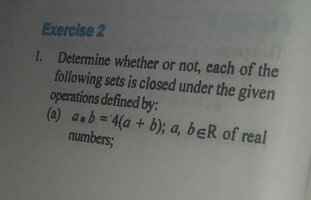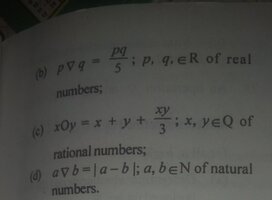Please take a look at this problem.
1. Determine whether or not, each of the following sets is closed under the given operations defined by:
(a) a∗b=4(a+b),a,b∈R
(b) p∇q=5pq,p,q∈R
(c) xOy=x+y+3xy,x,y∈Q
(d) a∇b=∣a−b∣,a,b∈N
I decided to go for (d):
Suppose a=1,b=2 then
1−2=−1
The set N is not closed under the given binary operations because:
−1ϵN
But on the other hand, if a=2, b=1 then:
2−1=1
I can now say that the set N, is closed because:
1∈N
What do you have to say about my idea on this problem?
1. Determine whether or not, each of the following sets is closed under the given operations defined by:
(a) a∗b=4(a+b),a,b∈R
(b) p∇q=5pq,p,q∈R
(c) xOy=x+y+3xy,x,y∈Q
(d) a∇b=∣a−b∣,a,b∈N
I decided to go for (d):
Suppose a=1,b=2 then
1−2=−1
The set N is not closed under the given binary operations because:
−1ϵN
But on the other hand, if a=2, b=1 then:
2−1=1
I can now say that the set N, is closed because:
1∈N
What do you have to say about my idea on this problem?
Attachments
Last edited by a moderator:



